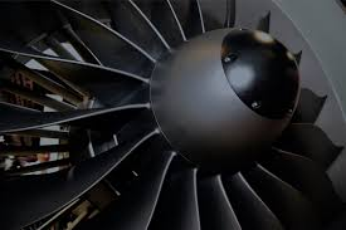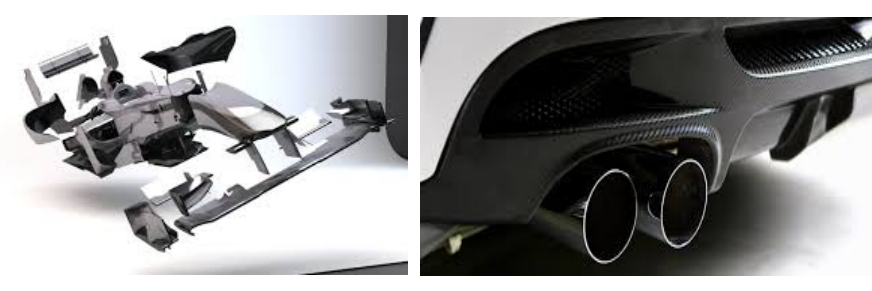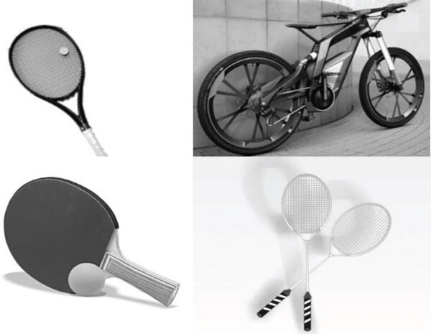Machining Carbon Fibre: Tools, Techniques, and Challenges
 May 28,2025
May 28,2025

Carbon is one of the most advanced materials in this era due to its unparalleled properties. Now, you see aircraft, airspace vehicles, formula cars, etc. These objects must be quick but have the lowest possible fuel consumption. The world is revolutionised now; the material of aircraft components has been shifted towards Carbon fibre from aluminium and steel. There are many other prospects of Carbon fibre, and you will be familiarised with them in this interesting article. So, let us provide you with a little introduction to carbon fibres.
What is Carbon Fibre? Why is it Popular in Machining?
Fibre means very thin filaments, etc. Carbon fibre is a composite material of very thin Carbon filaments which are bonded through epoxy. Carbon fibre is not used individually, more like it's a composite material. It is used with an epoxy matrix and becomes a carbon composite. It is commonly machined in the form of carbon fibre sheet or carbon fibre tube because of its high demand.
Understanding Carbon Fibre Properties
Before knowing the properties of carbon fibre, it is important to understand it through its composition.
- What is carbon fibre made of?
You will be amazed that carbon fibre is produced from organic polymers. Its main source is Polyacrylonitrile (PAN). Its 90% composition is only C atoms, which are arranged in a crystalline structure.
- What is so special about carbon fibre?
It is right that you ask why carbon fibre is so special. This answer is 90% C atoms arranged in a crystalline mode. This crystallinity provides exceptional properties, like when compared with steel, it is stronger than steel.
Lightweight and Strength
The most exceptional and highly rated property of Carbon fibre is its high strength-to-weight ratio. That's why carbon fibre is preferred in aerospace, automotive, and sports equipment.
High Modulus and Fatigue Resistance
Carbon fibre comes with a very high modulus, i.e. 200- 800 GPa, which is far higher than compared of steel. Wings made of C fibre can bear millions of cyclic stresses before the fracture (Fatigue Resistance).
Benefits of Carbon Fibre in Manufacturing
Carbon Fibre increases a vehicle's durability and performance by reducing the consumption of fuel, so it reduces cost. It can resist high temperatures easily.
Common Applications of Machined Carbon Fibre Parts
You are going to study a very interesting section of this article where you will get to know in which industries you can employ carbon fibre machined parts. Their strength and lightness enable them to develop structural parts.
Aerospace and Aviation Industry
High strength-to-weight ratio is the reason why we use C fibres in the aerospace and aviation industry. It is used in critical components such as the fuselage and rotor blades. Carbon fibre provides fuel saving and high speed.

Automotive Industry
Lightweight, High-Performance Car, e.g. formula Parts such as hoods, chassis and spoilers to enhance speed and control.

Sports Equipment and Consumer Goods
Yes, we use carbon fibres even in sports equipment and consumer goods such as:

- Bicycles
In frames, which become lighter and stiffer.
- Golf Clubs
For enhanced speed and accuracy, you can use carbon fibres in golf clubs.
- Tennis Rackets
Tennis rackets made of C fibre generate more power and provide better control.
CNC Machining Carbon Fibre: Techniques and Tools
Carbon Fibre is a very special material due to its properties, but its machining is difficult in the same manner. You will need very precise tools, such as a CNC machine and careful cutting of these C fibres. This section presents insights into how carbon fibres are machined, the techniques or tools and their advantages.
CNC Milling for Carbon Fibre Parts
CNC Milling creates an object by cutting the material from a flat or square/rectangular specimen.
Advantages of CNC Milling for Precision Cuts
There are many advantages to using CNC milling for precision cuts, like:
Due to the Automatic Tools Changing feature, the time for tool changing is reduced, so more production in less time. Advanced CAM software reduces 10 – 15% cycle times.
You can achieve a tight tolerance up to ±0.025 mm and surface finish, i.e. Ra <0.8 µm, using CNC milling.
CNC Turning and Lathe Techniques
If you have to machine cylindrical or tube-like shaped components of carbon fibre, like connectors, bushings or shafts, then it is advised to use CNC turning or Lathe techniques. These techniques are specifically designed for cylindrical shapes. In these machines, the workpiece rotates, but stationary tools keep removing the material from the surface till the final shape is achieved.
Advantages of CNC Turning for Cylindrical Parts
If you use CNC and Lathe techniques, you will have the following advantages over other machines:
- Through these techniques, you can make your component 30% faster than milling or other machines if it is a symmetric design.
- These machines maintain 0.05mm radial runout for balanced rotating parts.
- Since the material waste is lower in these techniques, they become cost-effective machining techniques, i.e. 25% vs milling.
Drilling and Cutting Carbon Fibre Sheets
Drilling means making holes in objects with drilling tools. The following are some common techniques for drilling and cutting carbon fibre sheets:
- Key Techniques for Hole Making
Drill Bits: Drilling bits are made of carbide drill at the speed of 3,000–5,000 RPM to prevent fraying (unwanted tearing or fibre breakage). These drills are pointed at a 118° angle.
Peck Drilling: In this drilling technique, you must retract (pausing the drilling process) after every 2-3mm drill to clean dust and maintain heat below 200oC.
It is better to choose a mandrel drill for carbon fibre to avoid the inner wall splintering.
- Edge Cutting in Carbon Fibre
Use spiral bits at 18000 RPM to avoid issues like delamination of carbon fibres from the matrix. The feed rate of 0.5 -1.5mm/min can help you clean edges. Do not forget to use mist cooling or air blowing during the cutting process. Cooling keeps the temperature lower than the resin's melting point.
Challenges & Solutions in Machining Carbon Fibre
As we told you earlier, carbon fibre alone is not used, but with epoxy matrix, i.e. Carbon fibre reinforced composite (CFRP). Due to the mixture of fibre and resin, there are many challenges in machining the carbon fibre. In this section, some common challenges and their solutions are given.
1. Abrasiveness and Quick Tool Wear
Carbon fibre is an abrasive material, i.e. 5-10X than glass fibre. If you use traditional cutting tools, they can destroy the material surface within minutes of the machining process. If your surface is not smooth, it will lead towards fatigue failure.
Solution: Using Stronger Tools
To avoid issues of surface roughness, you should use standard cutting tools. These tools can be diamond-coated or carbide tools. These tools are much harder than traditional cutting tools, i.e. high-speed steel.
2. Dust and Hazardous Fumes
If your sample contains carbon dust particles of (<5 µm), then this dust is problematic. These particles are classified as potential carcinogens because of their potential for lung irritation. And if these particles are conductive, then they cause shortening of CNC electronics during the machining process.
Solution: Control Dust with Vacuums and Water
To mitigate this issue, you can use HEPA Vacuum Systems or Wet Cutting. Vacuum captures 99.66% of dust particles, so the risk is reduced now. Wet cutting can reduce these particles to 90%.
3. High Costs from Scrapping Parts
CFRP is an expensive material, so it requires very careful machining. If the cutting rates or other standards are not met, the scrap rate can increase 15-25%, which is not fine in the case of this material.
Solution: Optimise Cutting Settings
If you follow these optimised parameters, your scrap rate can be reduced to 5%.
|
Parameter |
Optimal Range |
Effect |
|
Spindle Speed |
18,000–24,000 RPM |
Prevents resin from melting |
|
Feed Rate |
0.05–0.1 mm/tooth |
Reduces fibre pull-out |
|
Depth of Cut |
≤0.5 mm |
Minimises delamination risk |
4. Delamination and Surface Damage
If, during the machining process, such as drilling or edge trimming, fibre layers separate from the matrix, it is called delamination. It affects mechanical properties. The strength is reduced by 50-60%.
Difficulty Achieving Precision Cuts
We know that carbon fibre is an anisotropic material, which means its mechanical properties are different in different directions. It's this behaviour that limits us to machine carbon fibre composite carefully. Resin degradation or layer separation is another issue.
Solution: High-Precision CNC Machines
CNC machine is a very advanced machine which is equipped with automatic tool changing capability, an extremely stable workpiece, and advanced cutting strategies are considered as a solution for high-precision machining. It is called carbon fibre CNC service in the case of carbon fibres.
Cutting Carbon Fibre: Methods and Equipment
As we told you earlier, layers of a carbon fibre reinforced polymer (CFRP) composite respond differently to cutting tools. It is a highly abrasive material, and its matrix, i.e. made of resin, is heat sensitive. These things make carbon fibre difficult to cut.
Waterjet Cutting for Carbon Fibre
As the name itself shows that water is used to carbon fibre, although it feels crazy like how water can cut carbon fibre. It is not like normal water; it comes with very high pressures, like 60,000 – 90,000 psi, and secondly, mixed with abrasive particles. The pressure of the water causes the carbon fibre to cut into pieces.
Why Waterjet Cutting Is Ideal for Precise Cuts?
The following are the reasons why we consider it an ideal cutting tool for carbon fibres:
- No heat-affected zone on the CFRP composite
- No mechanical stress on the adjacent parts
- High-quality and precise cuts
Laser Cutting Carbon Fibre: Pros and Cons
Laser cutting cuts carbon fibres using a high-energy laser beam. This beam falls onto the target area, burns through the thickness and cuts the composite.
- Pros:
- Production rate is very high, i.e. 10x of waterjet
- Used for large volume productions
- More precise cuts than waterjet
- Cons:
- Generates a heat-affected zone
- Toxic fumes
- Preferred for thickness up to 3mm
Abrasive Cutting: A Comprehensive Look
The following table presents a comprehensive look at abrasive cutting techniques.
|
Method |
Best For |
Key Advantage |
Limitation |
|
Diamond Band Saws |
Thick CFRP (>25mm) |
No heat, portable |
0.5-1.0mm kerf waste |
|
Diamond Grinding Wheels |
Edge finishing |
0.05mm precision bevels |
Requires flood coolant |
|
Ultrasonic Cutting |
Delicate laminates |
60% less delamination |
$75k+ equipment cost |
Essential Machining Tools for Carbon Fibre Parts
In this section of the article, we will discuss some essential machining tools for carbon fibre parts.
Top1-Diamond-Coated Cutting Tools
Since the carbon fibre is a very abrasive material that's why it is necessary to pick a tool which provides a smooth finish. In this regard, Diamond-Coated Cutting Tools are considered the best tools for minimising wear and improving surface finish.
Top 2 CNC Machines with High RPM and Rigidity
- CNC machines are very good here in this case, why, let's figure out:
- Very high RPMS, 25,000 – 60,000 RPM, will help you to control fibre pull-out.
- Due to harmonic control, it eliminates vibrations at the interface of the composite.
- You can achieve the surface finish up to 0.1µm Ra.
3-Specialised Composite Cutters for Carbon Fibre
Some cutting-edge innovations for cutting carbon fibres include:
- Diamond-like Carbon Coated tools
- Through-Tool coolant
- Ultrasonic Assisted
Safety Measures When Machining Carbon Fibre
For a better outcome of machining carbon fibre, it is important to follow safety measures. Some of them are discussed in this section:
Using Protective Gear for Dust and Fumes
When you are machining carbon fibres, especially through lasers, they release toxic fumes and very small carbon particles. These fumes cause lung irritation and skin rashes. To avoid such issues, use PPE (goggles, glasses, mask, etc.)
Ventilation Systems and Air Filtration
- Use proper ventilation and air filtration systems. Such as,
|
Filter Type |
Efficiency |
|
HEPA (H13) |
99.95%@0.3µm |
|
ULPA (U15) |
99.9995%@0.1µm |
- Ambient air monitors like VOC (volatile organic compounds)
Waste Disposal and Environmental Impact
To control waste disposal and reduce its environmental impact, you should recycle scraps and follow local rules and regulations for hazardous waste.
Conclusion
After the whole discussion, we conclude that carbon fibre is a very promising material which is used in important industries such as aerospace and automotive. Since their machining is very difficult, its future of machining lies in CNC advancements. Industry 4.0 is trying to shape the future of carbon fibre machining through automation and AI optimisation. To remain ahead of the market, it is important to remain in touch with smarter innovations.
FAQs
What is the best tool to cut carbon fibre??
For the cleanest cuts, use diamond-coated cutting tools.
Can you machine carbon fibre without creating dust?
Yes, waterjet cutting does not create dust during cutting the carbon fibre.
Why do car guys love carbon fibre?
Because it is lightweight, stronger, provides high-speed, control and saves fuel consumption.
 Tel/WeChat:
Tel/WeChat:  Email:
Email: 
 Home
Home
 Depth of Cut in Machining: Formulas, Limits, and Optimize
Depth of Cut in Machining: Formulas, Limits, and Optimize 







